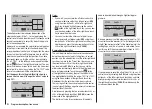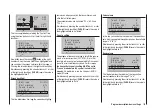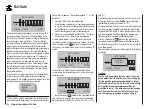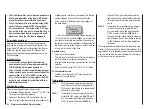
142
Program description: Telemetry menu
For each selected OUTPUT CH (receiver servo socket)
you can choose between:
FAI(L) SAFE
•
If interference occurs, the corresponding servo
moves to the position displayed in the “POSITION”
line for the duration of the interference, after the “de-
lay time” set in the “DELAY” line.
HOLD
•
If interference occurs, a servo set to “HOLD” main-
tains the position last assessed as correct for the du-
ration of the interference.
OFF
•
If set to “OFF” when interference occurs, the receiv-
er continues to send the last correct control signals
(which it has stored) to the corresponding servo out-
put for the duration of the interference. This can be
imagined as the receiver switching the signal wire
“off”.
But CAUTION: if the control signal is absent, ana-
logue servos and many digital servos offer no resist-
ance to the forces acting on the control surfaces, with
the result that the model’s control surface positions
are more or less quickly lost.
F.S.Pos. (Fail-Safe position)
For each OUTPUT CH (receiver servo socket) activate
(highlight) the value field by briefly pressing the central
SET
button of the right-hand touch-key, then use the ar-
row buttons of the right-hand touch-key in the “F.S.POS.”
line to set the servo position which the servo is to take
up in “FAIL-SAFE” mode if interference should occur.
The setting can be entered in increments of 10 μs.
Default setting: 1500 μs (servo centre)
Important note:
The “F.S.POS.” function is also significant if the receiver
is switched on, but is (not yet) receiving a valid signal;
this applies to all three modes “OFF”, “HOLD” and “FAIL-
SAFE”:
The servo immediately runs to the Fail-Safe position pre-
viously set in the “Position” line. This can be exploited,
for example, to prevent the operation of a retractable un-
dercarriage or similar function if the receiver is switched
on accidentally. However, during normal model opera-
tions the corresponding servo behaves in accordance
with the set “MODE” if interference should strike.
DELAY (fail-safe response time or delay)
At this point you can set the delay time after which the
servos are to run to their previously selected positions if
the signal should be interrupted. This setting applies to
all channels, but only affects the servos programmed to
“FAIL-SAFE” mode.
Default setting: 0.75 s
FAIL SAFE ALL (global fail-safe setting)
This sub-menu can be used to define the Fail-Safe
position of the servos simply by “pressing a button”; it
operates in a similar manner to the “
Fail-Safe
” menu
described on page 136, and is simple to use:
Move to the “FAIL-SAFE ALL” line and press the central
SET
button of the right-hand touch-key to activate the
value field; “
NO
” is highlighted (black background). Now
set the parameter to “
SAVE
” using one of the arrow
buttons of the right-hand touch-key. Use the transmitter
controls to move all the servos which you have assigned
- or intend to assign later - in the “MODE - FAIL-SAFE”
line, to the desired fail-safe positions. In the extreme
bottom line “Position” displays the current position of the
transmitter control for the channel you have just set:
RX FAIL SAFE
INPUT CH: 01
MODE : FAI-SAFE
F.S.POS. : 1500µsec
DELAY : 0.75sec
OUTPUT CH: 01
POSITION : 1670µsec
FAIL SAFE ALL:
SAVE
After touching the central
SET
button of the right-hand
touch-key once more, the display reverts from “SAVE”
to “NO”. This indicates that the position of all the servos
affected by the procedure have now been stored, and
have also been adopted in the “F.S.Pos.” line. At the
same time the position for the current OUTPUT CH
(servo socket) is immediately displayed on the screen.
RX FAIL SAFE
INPUT CH: 01
MODE : FAI-SAFE
F.S.POS. : 1670µsec
DELAY : 0.75sec
OUTPUT CH: 01
POSITION : 1670µsec
FAIL SAFE ALL: NO
Switch the transmitter off, and check the Fail-Safe posi-
tions by observing the servo movements.
“Fail-Safe” in combination with “channel mapping”
It is clearly desirable that mapped servos - i. e. servos
which are controlled by a common control channel
(INPUT CH) - should respond in the same way when
interference occurs,
so the corresponding settings of the
INPUT CH determine the behaviour of mapped servos
.
For example, if receiver servo sockets 6, 7 and 8 are
mapped together, i. e. if the same control channel “04”
is assigned to OUTPUT CH (servo sockets) 06, 07 and
08 …
Summary of Contents for mx-12 Hott
Page 1: ...Programming Manual 33116 mx 16 HoTT 3 en mx 16...
Page 35: ...35 For your notes...
Page 49: ...49 For your notes...
Page 55: ...55 For your notes...
Page 59: ...59 For your notes...
Page 63: ...63 For your notes...
Page 69: ...69 For your notes...
Page 91: ...91 For your notes...
Page 101: ...101 For your notes...
Page 123: ...123 For your notes...
Page 181: ...181 For your notes...
Page 193: ...193 For your notes...






























